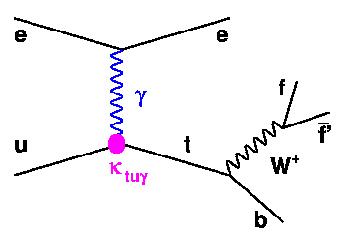|
Among the known elementary particles, the top quark is the heaviest. Its mass
is around 175 GeV, almost 200 times heavier than the hydrogen atom and about
the same mass as the gold atom. Due to its very short lifetime, the top
quark doesn't exist in our everyday environment. To produce and study the top
quark, it is necessary to collide very high energy particles
in large accelerators.
For example, the first observation of the top quark (1995)
was in the collisions
of two proton beams in the TeVatron accelerator at Fermilab near Chicago.
The physics of the top quark is particularly interesting due to its huge mass, which may be related to unknown properties of matter at very short distances. There are good reasons to think that top quark physics may give a first insight into new phenomena. 
Top quark production is identified from the decay products, which give rise
to a rather spectacular event signature. As shown in the
figure, the
top almost always decays to the lighter b quark and the W electroweak gauge
boson. The b quark can be observed as a jet (shower) of strongly interacting
particles (hadrons). The W boson may decay into a further pair
of jets or into a lepton (electron or muon) and a corresponding
invisible neutrino.
This latter signature, with a high transverse momentum jet, an isolated
lepton and missing transverse momentum, has been observed by the H1 experiment
at HERA (see
DESY-02-224 ) at a much higher rate than expected,
suggesting that the experiment may be producing top
quarks. However, the available collision energy at HERA of around 300 GeV is
not sufficient to produce top anti-top quark pairs, as occurs at the TeVatron,
but only single top quarks. The well established Standard Model of elementary
particles does not contain a mechanism for producing single top
quarks at a rate that would make them visible at HERA. The H1 top quark
signature may thus be associated with a non-standard or `anomalous'
production mechanism, signalling new physics. The H1 collaboration has
investigated other possible sources of the observed signature, for example
due to backgrounds or mismeasurement, and has performed a statistical
analysis to quantify the level of the
observed anomaly.
The search found 5 good candidates for top quark production, compared with an expected background of 1.3 events. This difference is still small enough that it may be explainable as a statistical fluctuation, so the spectacular events do not yet give clear evidence for an anomaly in HERA data. However, the puzzle of these 5 events remains. Their production rate is not inconsistent with the limits set on anomalous production mechanisms by other high energy experiments around the world. As the HERA experiments will go on running for several years yet, it is hoped that the mystery will be solved by the observation or non-observation of more similar collisions in the future data. The analysis thus shows that the HERA collider could still be the source of the next big new discovery in physics! |